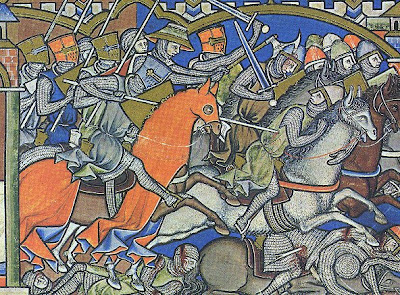The extremely dangerous Sir John Deyville, doing what he did best
Sir John Deyville - or de Eyvill, D'eyville etc, the name was spelled in many different ways - is a largely forgotten Yorkshire knight who played a vital role in the rebellion of Simon de Montfort and its aftermath. He also plays an important role in my upcoming novel, Nowhere Was There Peace, so I thought it worth posting about him. John was the living prototype of the 'robber knight', a fierce and stubborn man who spent much of his life on horseback, galloping from one blood-soaked encounter to the next.
Born c.1230, John was a troublemaker from his youth. In 1248, while still a minor, he was charged with violent entry into William de Vescy's Yorkshire manor of North Anston. A few years later, in 1253, he had fallen foul of the church and was reported to be 'fleeing from county to county and afterwards beyond sea' following excommunication. Even by the rough standards of medieval barons, this was an unpromising start.
By the late 1250s, John was back in England and back in favour, and rose rapidly to power and status thanks to his alliance with the powerful Richard de Clare, Earl of Gloucester: he was named as one of the Earl's 'friends and allies' in the letter of March 1259 in which de Clare swore loyalty to the Lord Edward, Henry III's son and heir. Even so, within a few years John was firmly in the rebel camp of Simon de Montfort, and was to pursue a spectacularly bloody and violent course in the civil wars that wracked England in the 1260s.
While Simon de Montfort was waging war against the King in the south, John stirred up trouble in the north and made life as difficult as possible for the royalists. He refused a royal command to give up his fortified manor at Hode in North Yorkshire, and in December 1263 he and a party of barons forced their way into the city of York. They 'took up their abode where they would, and spent Christmas there'. The citizens coughed up £100 to get rid of them, though not before the barons had laid waste to the abbot of York's lands in Boutham and St Mary's Street.
Following De Montfort's victory at Lewes, John was unrestrained in the north, and took advantage of the chaos to bargain for personal power and exercise his talent for destruction: in 1264 a royal officer named Peter de Percy was compensated for food and wages paid to his soldiers while chasing John and his accomplices as they rampaged through Yorkshire, burning and pillaging at will.
The Battle of Evesham in 1265, where Simon de Montfort was defeated and killed, saw a spate of noble bloodletting unknown since the Norman Conquest.
This was a taste of things to come. John was more at home with guerilla warfare than pitched battles, and for some reason was not present at Evesham in 1265, where Simon de Montfort and his army were exterminated by the vengeful Lord Edward. After the slaughter of Evesham, many of the surviving baronial rebels were intimidated enough to lay down their arms, but not John and his equally ferocious relatives. While he established a rebel camp among the watery fastness of the Isle of Axholme in Lincolnshire, his cousin Nicholas led another band of rebels in the woods of Nottinghamshire and Derbyshire. His younger brother Robert joined the rebels at Axholme, along with a host of lesser knights and retainers.
Without Simon de Monftort's guiding influence, these men and others like them were poised to embark on an orgy of destruction in revenge for the death of their leader and their own disgrace and disinheritance. Fire and blood will follow in Part Two...
References:
I must chiefly credit Oscar de Vill for his fine series of essays and articles on the medieval Deyville family. These include:
1) Oxford Dictionary of National Biography (2004): 'Sir John de Deyville'
2) Medievalists' Seminar (1998): 'John Deyville'
3) Medieval Prosopography, 19 (USA, 1997): 'Deyville (or de Daiville): Origins of an English Regional family'
4) Northern History, XXXIV (1998): 'John Deyville, A Neglected Rebel'
6) Nottingham Medieval Studies, XLII (1999): 'The Deyvilles and the Genesis of the Robin Hood legend'


No comments:
Post a Comment